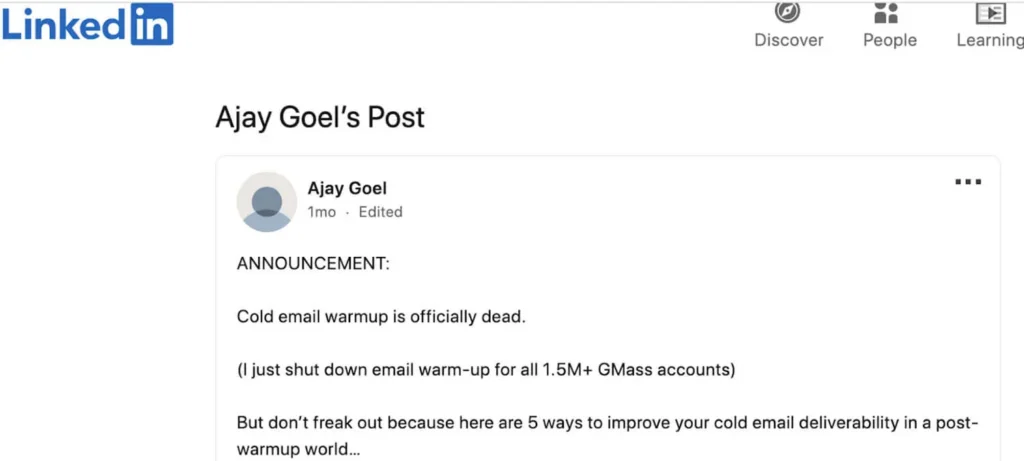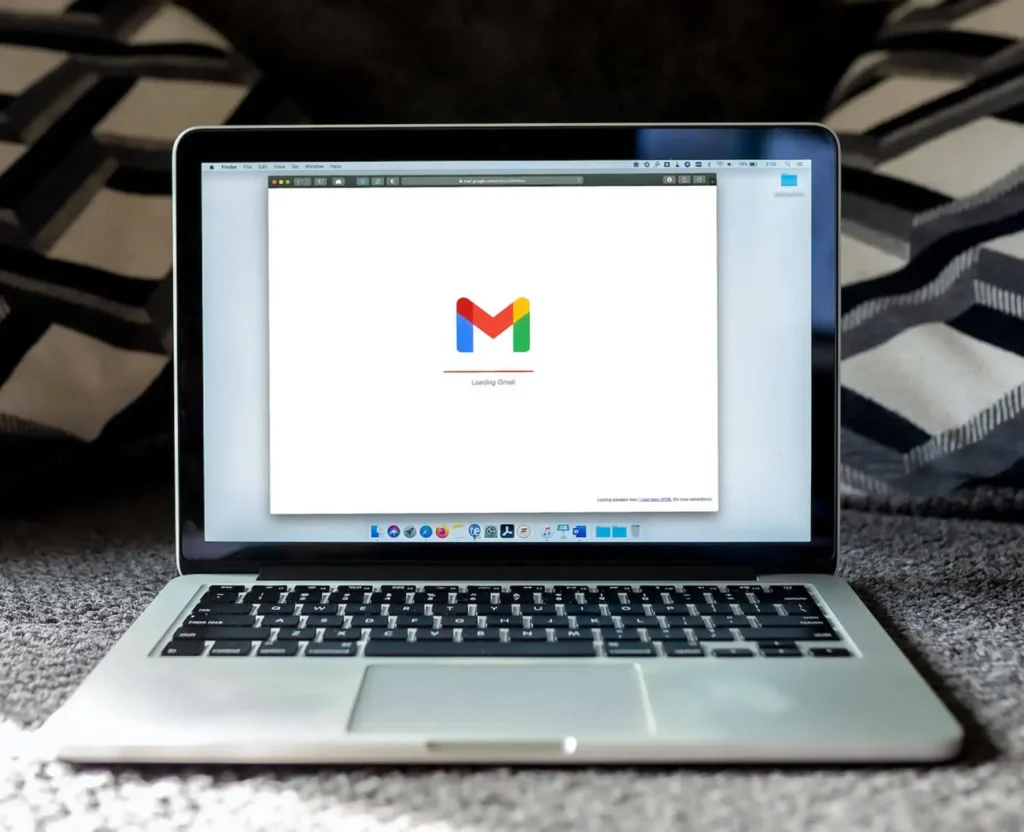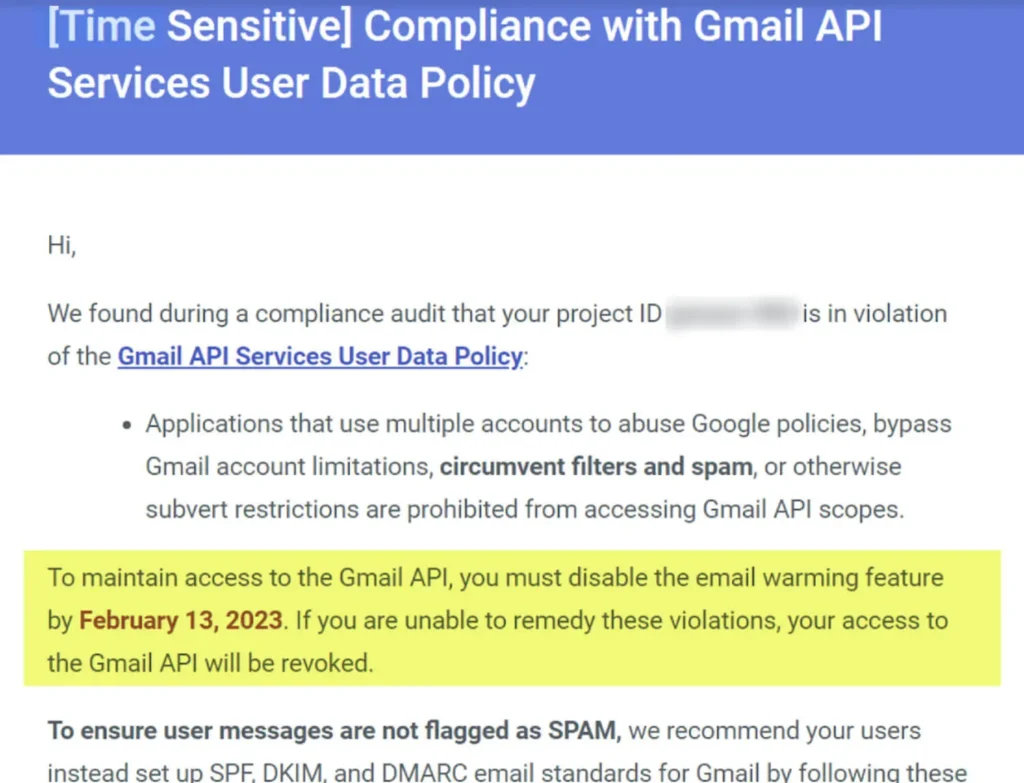Cold email warmup is official dead
Ajay Goel, CEO of GMass
In a shocking development for email marketers everywhere, Google, the world’s largest email provider, decided to effectively ban automated email warming services that use Google’s direct API in February 2023.
The fallout was swift …
Ajay Goel, CEO of GMass, the email outreach service that allows you to send personalized mass emails from your Gmail account, announced that his GMass email warmup service would shut down email inbox warmup for all 1.5 million accounts.

That collective WTF??? you hear is thousands of email marketers scrambling to figure if cold email warmup is actually dead – or if it’s just a step backwards to the stone age days of manual warmup.
Fear not our friends, it’s not all doom and gloom. While we hold the highest respect for Mr. Goel, we can confidently say that email inbox warmup is not dead … it just will look a bit different in the future.
In fact, you can read on to find out why we think email marketing will actually improve with the recent developments (yes, you heard us right!)
Enough of the intro, you came to learn about the Gmail warmup ban … and that’s what we’ll give you. We’ll find out:
- Why Google banned direct API cold email warmup;
- What does Google’s decision mean for you?;
- Great alternatives for cold email warmup; and4) How to improve cold email delivery in light of Gmail changes;
Let’s get started …
Have a question about email warming services? Contact us at info@inboxy.io to learn how to quickly warmup your email inbox in an effective and affordable way.
Why Did Google Ban Automated Email Warming Services?
Simply put, Google banned API-based automated email warming services because it cheats the system. Direct API automated email warmup is in no way illegal, however, it was an abusive workaround to bypass spam filters.

So why exactly did Google effectively ban automated email warming services?
In a communication from Google to GMass on why Gmail would be banning API-based cold email warmup services such as GMass, they stated:
Applications that use multiple accounts to abuse Google policies, bypass Gmail account limitations, circumvent filters and spam, or otherwise subvert restrictions are prohibited from accessing Gmail API scopes.
Let’s not overcomplicate this … it all comes down to good business. Let’s break it down:
If marketers are fooling the Google system to trick it into believing spam emails are legitimate, MORE spam emails will make it through to inboxes.
If MORE spam emails make it through to inboxes (which, let’s be honest, we all receive dozens of spam emails a day) Google users and customers will lose trust in Google’s ability to regulate their email platform.

If users lose trust in Google, they will begin to look to other, more trustworthy email platforms – which will drive users away from not only Google’s email platform, but also their market leading search engine.
Less users for Google means that less businesses will want to advertise on Google – which can mean hundreds of billions of dollars in lost business for the company.
Follow the money, and you will find your answer.
What Does the Google Automated Inbox Warmup Ban Mean For You?
Long story short (we all prefer short stories, don’t we), email marketers will no longer be able to use automated warm-up features for Google accounts using API.
The ban means that email marketers cannot use any API-based automated warmup tools for Gmail accounts. Considering Google is the most popular email delivery platform with 1.5 billion active global users, this is a very significant development for businesses who rely on email marketing.
But there has to be a workaround, right?
Well, not really. Any business that does not adhere to Google’s terms will risk losing their API access – which would definitely be a fatal blow to any email marketing business.

How about other email providers – will they ban the same practice?
While there hasn’t been any known action yet by other email providers (Outlook, Yahoo, AOL), all you need to do is follow the tracks of the 10,000-pound gorilla to see where things are going.
As THE market leading email platform, the trend to eliminate automated cold email warmup will surely spread to other email providers in the near future.
Rather than waste time searching for a workaround – it’s time you found new tools and adopted best email practices to ensure your emails hit the inbox.
As THE market leading email platform, the trend to eliminate automated cold email warmup will surely spread to other email providers in the near future.
Help! Are There Other Cold Email Warmup Services We Can Use For Our Business?
Cold email warmup is dead … long live cold email warmup!
It’s time to get real: cold email warmup is NOT dead, it’s just not going to look the same as it has for the past few years.
The truth is, API email warmup was never going to last for long. The tactic was a clear workaround of Google’s filters, and it allowed unethical marketers to deliver millions upon millions of spam messages to your inbox.
This is where an IP warm up service like Inboxy can help. Let’s quickly look at the differentiators that make Inboxy an equally effective (if not better) solution than the API-based inbox warm up services.
- Inboxy uses hyper-targeted email warmup based on the network you’re having a problem with. For B2B, it’s mostly either Google (i.e. Google Workspace) or Microsoft (Office365). Rather than take a “silver bullet” one-size-fits-all approach, Inboxy focuses on the email network you are having trouble with (remember, you may have trouble with one email network, but will be fine with another). This hyper-targeting strategy is custom-tailored to your business needs and more quickly effectively solves email related issues
- Unlike GMass that used direct API (Google’s main beef), Inboxy uses headless browsers – and therefore are not affected by the Google ban. “Headless” means a web browser without a user interface. Headless browsers access the web page, but the GUI is hidden from the user.
- Rather than a public network to warm your inbox, Inboxy uses their own private network which is a safer, more controlled, and more effective way to warm inboxes.
There’s certainly other email inbox warmup tools on the market to choose from, but the effectiveness, transparency and affordability of Inboxy makes it a no-brainer if you are one of those clients who were recently shut down by GMass.
Contact us at info@inboxy.io to learn more! We’d love to show you are our inbox email warming services work!
Five Ways to Improve Your Cold Email Deliverability According to Inboxy CEO Erik Paulson
With Google putting a ban on automated inbox warmup, you can always go the manual route with cold email warmup.
Does it require tedious work? … yes
Is it time consuming? … yes
Will you pull your last remaining hairs out trying to figure out why your emails are still going to spam … definitely.
However, manual inbox warmup was THE original email warmup method and you should find great success if you take the time to learn email best practices.
With that in mind, Inboxy CEO Erik Paulson is giving us 5 quick ways to improve cold email delivery in this strange new world we find ourselves in:
1) Write quality, non-spammy emails
High quality, professional sounding emails are more important than ever, says Mr. Paulson.
“When you first get your email domain, try to write emails like you are emailing your boss,” says Paulson. Full sentences, good grammar, no excessive use of exclamations. Go easy on pictures, emojis, buttons – anything that would raise suspicion with a spam filter.”

Stay away from these big NO-NO’s that may cause your emails to erroneously be flagged as spam:
- Using multiple fonts within an email. Just stick with one font!
- Using “spammy” words. There are a whole lot of spam trigger words and phrases (i.e. “sale” “free” “cash” “buy “cards accepted”) that can set off the spam filter and land your email in the junk folder.
- Too many pictures. One or two pictures is fine … but chill with the photo album.
- Bad grammar, spelling and punctuation mistakes. Make sure to proof your emails so they don’t sound spammy.
- Too many exclamation marks or writing in all-caps almost doubles your chances of getting labeled as spam!!!. Excessive exclamation marks are often used by scammers to create a fake sense or urgency and, therefore, have negative connotations!!!
- Links to suspicious websites.
- Emails that are too heavy. The optimal size of an email is 30kb or less.
Bottom line: high quality, professional emails will lead to better inbox placement!
2) Slowly ramp up your email campaign
One of the biggest mistakes in cold email marketing is sending too many emails too fast. The best way to assure you find your emails in the spam folder is to send 100 emails the first few days your new inbox is live.
Sending too many emails in a short amount of time, or quickly adjusting your sending patterns, will raise red flags. A sudden increased flow of email from an IP address without an established reputation looks suspicious – which may lead to your mailbox provider sending your email on the fast train to your recipient’s spam folder.

To avoid this issue, you want to “throttle” your email sending during the first 30-60 days of your new account. Throttling means that you are gradually ramping up your email frequency in a systematic, but random way, as not to seem like you are purposefully tricking the spam filter.
Paulson recommends that you gradually ramp up your email frequency by sending just 1-2 emails a day for the few days, then slowly ramp up to 3, then 5, then 10, and so on.
“Slowly ramping your email frequency is a signal to email providers that you are not a mass mailer,” says Mr. Paulson. “Like any new relationship, gaining the trust of the email providers takes more than a day.”
3) Setup DKIM, DMARC & SPF
With a new email account, the first thing you want to do is make sure you setup proper account authentication. Authentication helps to ensure your account is protected from spam filters and increases your email deliverability.
There are three essential email authentications:
- SPF
- DKIM
- DMARC
What do these all mean?
SPF: Sender Policy Framework is an authentication technique that creates a record in your DNS (Domain Name System). An SPF record added to DNS servers tells recipient email servers that a message came from an authorized sender IP address or could be from a phishing campaign. It’s an essential component in email security and gives administrators a way to block phishing emails from reaching an intended victim.
DKIM: Domain Keys Identified Mail is an authentication method that adds a digital signature with your domain, which prevents email spoofing and helps your email reach the right place.
DMARC: Domain-based Message Authentication, Reporting & Conformance records to use your SPF and DKIM records to assure the receiver’s ESP that no unscrupulous activities are associated with the email.
Saleshandy has a helpful tutorial on how to set up your SPF and DKIM records.
4) Pause Between Email Sends
For the first few weeks, Mr. Paulson recommends having a 5-10 minute pause between email sends. “Sending an email every few seconds or minutes might raise a red flag about your account,” says Paulson.
The recommendation is to slow down and take it nice and easy during the first month of warming your email inbox. We can’t overstate that you have to establish trust with your email provider.
Conclusion
Is email warmup dead? Absolutely not.
Yes, certain email warmup workarounds which trick and cheat email filters are dying out – but you should consider that a positive development.
Abuse of the system means that the spammers are winning. By tricking the filters using direct API, they are able to get their spam email inboxes warmed up immediately, and flood YOUR inbox with spam email.
This makes it harder for legitimate inboxes to make it through the rigorous spam filter tests – meaning that legitimate businesses like yours suffer with emails that land in spam folders.
This is not the end of inbox warmup – it’s just back to basics. There are amazing tools like Inboxy that can help you affordably and legitimately warm up your email inbox at a very reasonable cost.
We hoped you learned something useful today! If you want to learn more about Inboxy’s email warmup service, we’d love to chat with you by contacting us at info@inboxy.io.
Until next time,
Erik Paulson
CEO, Inboxy